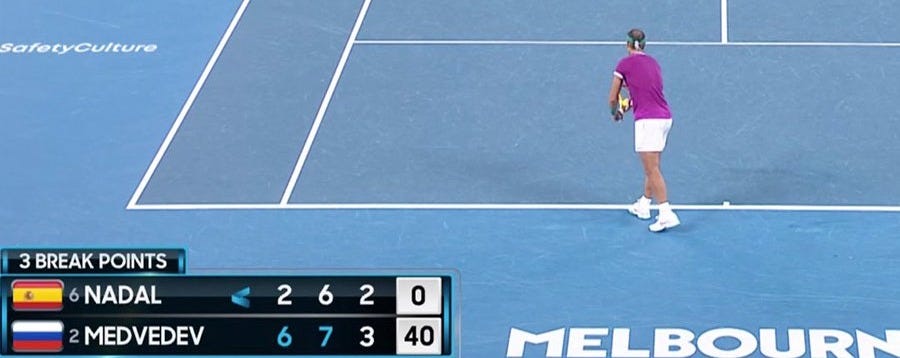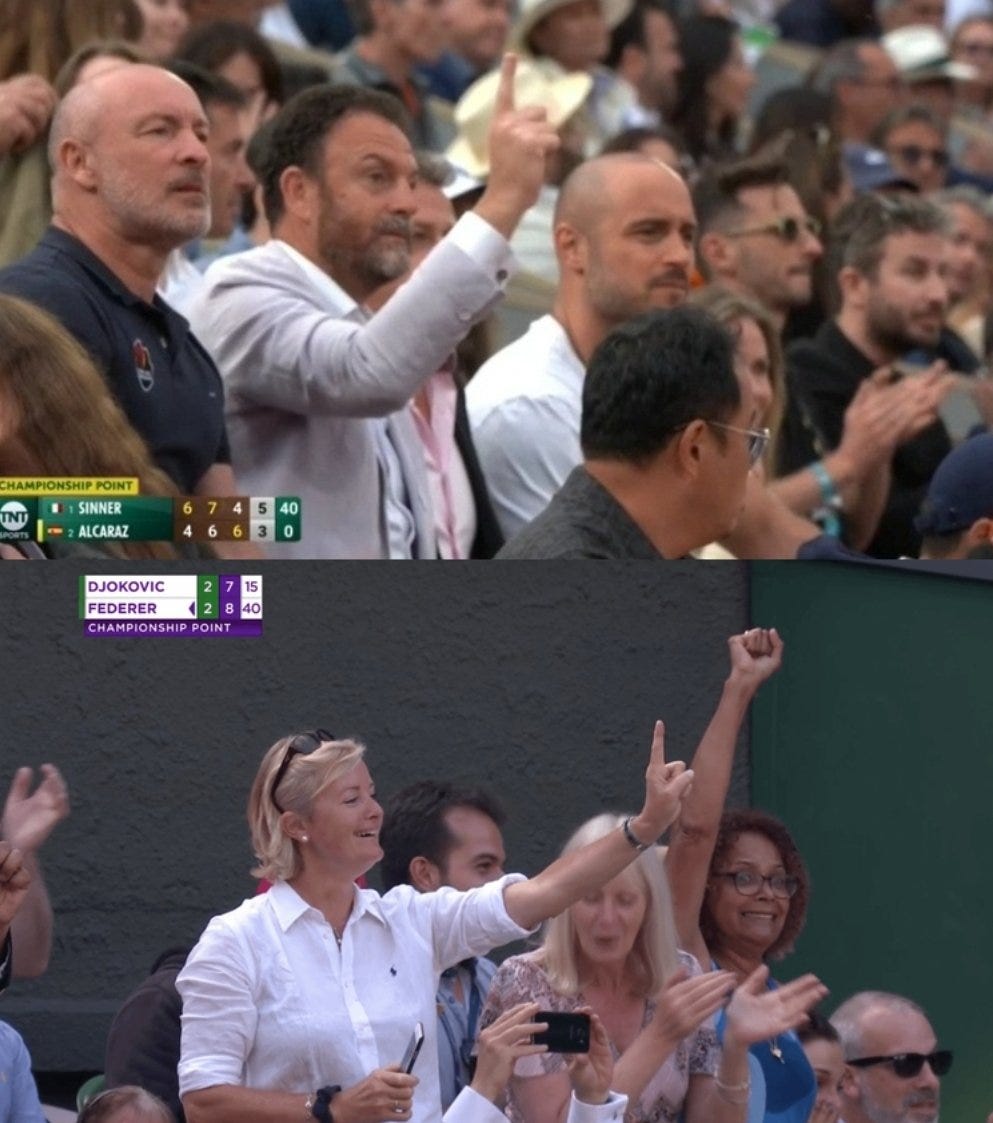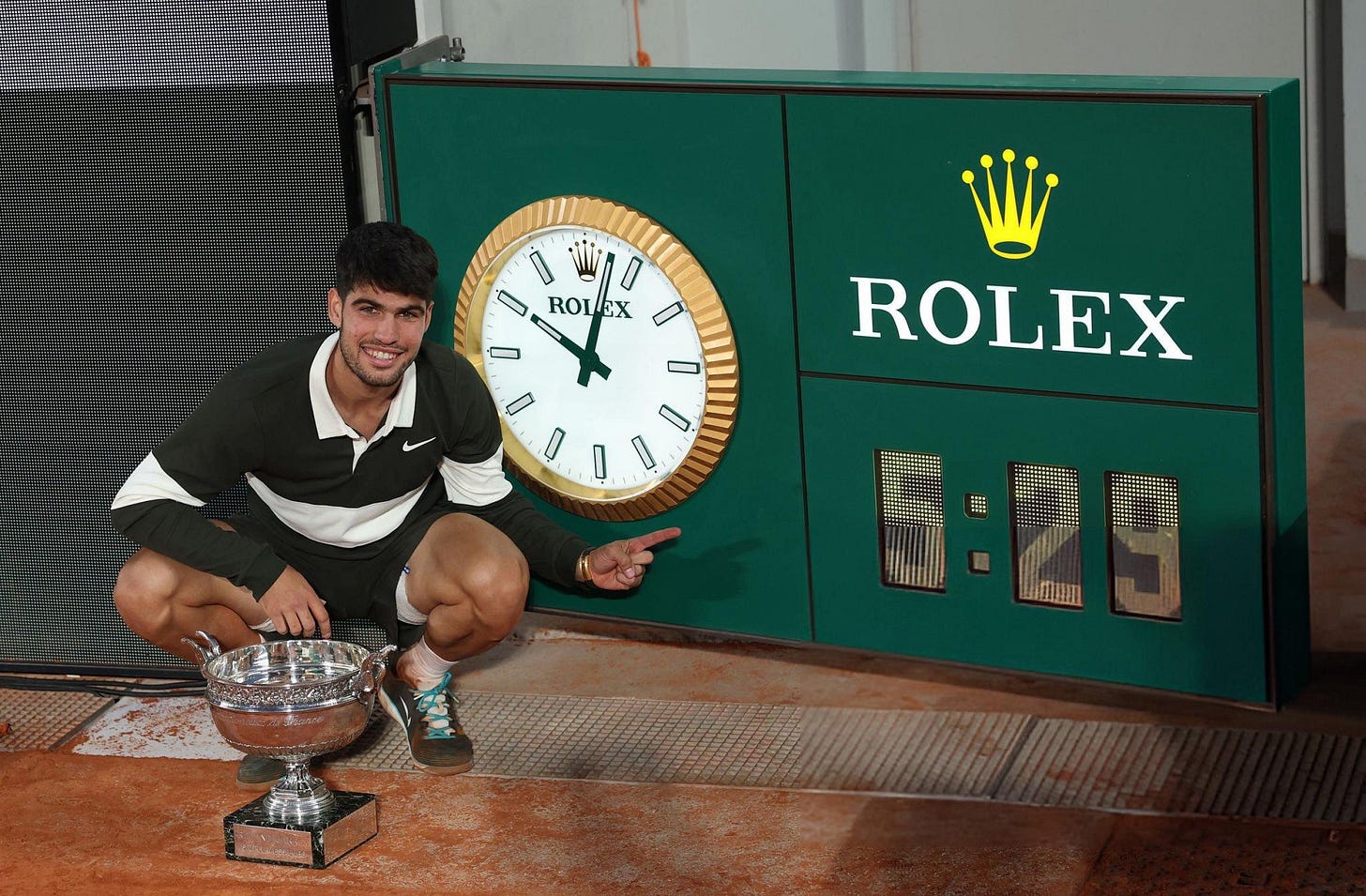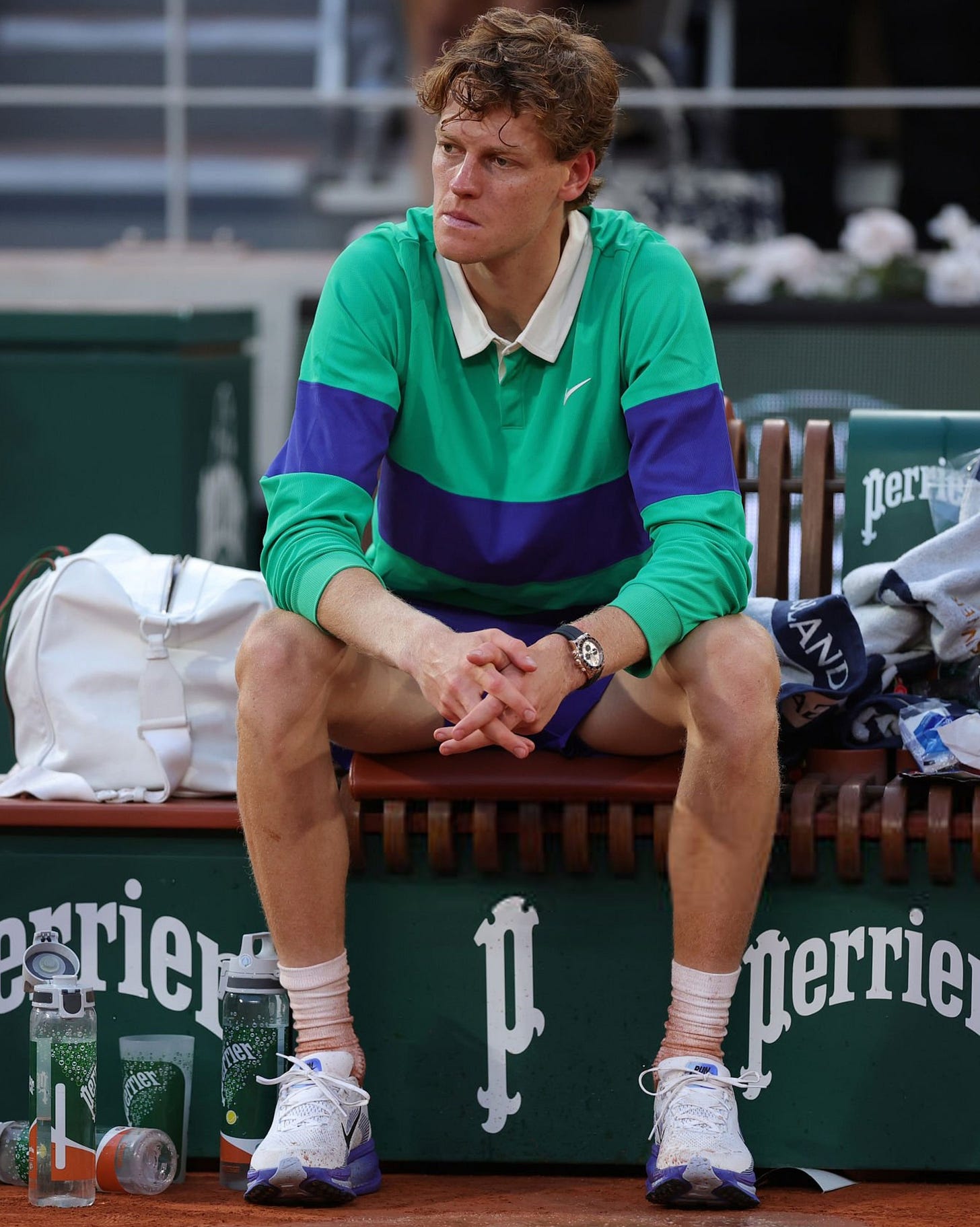The Sinner-Alcaraz Rivalry Becomes Iconic
Carlos and Jannik fulfill their destiny and join the pantheon of all time great rivalries
Rivalry - ri·val·ry/ˈrīvəlrē/ noun;
competition for the same objective or for superiority in the same field.
It’s a gift to be able to pinpoint, in real time, when exactly a rivalry became iconic. It happened for the Jannik Sinner-Carlos Alcaraz rivalry during the fourth set of the 2025 Roland Garros final when the score-line looked like this:
And then Alcaraz saved three championship points, won the game with an outrageous winner (off a pretty great return by Sinner) and the crowd jumped to their feet. Carlitos held his hand to his ear and swaggered to his chair like a man who knew he was going to a fifth set. Suddenly, we were watching a match that carried the air of something not only historic, but epic.
The ink on Rafa Nadal’s plaque embedded within the red clay of Court Philippe Chatrier had barely dried, and suddenly Jannik Sinner and Carlos Alcaraz had catapulted their rivalry into the pantheon with the likes of Borg-McEnroe and Federer-Nadal-Djokovic.
And even though the 2025 Wimbledon final didn’t live up to the hype, it deepened the rivalry by causing a disruption in Alcaraz’s dominance. Because a rivalry can’t be about one dominating another, a true rivalry requires each to wound the other.
“Nothing is of its own explanation. Is there a better description of a cube than that of its construction?”
- László Tóth, The Brutalist (2024)
A Rivalry Becomes Unique to its Own Construction
The all time rivalries— Ali-Frazier, Borg-McEnroe, Bird-Magic, Martina-Chrissy and Nadal-Federer— go beyond just competition for superiority in the same field, their rivalry has its own gravitational force, born of the opposition and shared mythology. They elevate and transform both into something greater than they could be alone.
The great ones share not only athletic but philosophical differences. Icy Borg and fiery McEnroe, Ali’s élan and eloquence, Frazier’s power and hyper-competency, Federer’s Swiss precision and Nadal’s Spanish passion.
Alcaraz is fueled by emotion, he wants to push the crowd into hysterics, like joy itself is the whole point. Alcaraz’s game is a celebration of going for the big shot with reckless abandon. He’s inconsistent, but when he’s riding high, smiling and playing free, his whole body springs into his forehand, his arm whipping out toward the ball like a scorpion’s tail, so fast you barely can see it strike.
Sinner is an engineer of angles, mathematical in his commitment, menacingly consistent. While Alcaraz’s game can be non-linear, Sinner plays in a straight line, but the line is drawn with a machine gun. His ability to hit 30 identical forehands with exactly zero deviation in shape or depth makes the rest of the tour feel like he’s playing at 2x speed1. Sinner runs cool, rarely showing emotion other than a pronounced fist pump, even when a cloud of controversy looms over his head, he still has the same game —unrelenting, militant, like a massive tank blitzing you with a constant barrage that grounds you into dust.
Coming off the heels of The Big Three era, you can’t help but see the Sinner-Alcaraz rivalry through the lens of that tri-valry. The instant classic Roland Garros final was a Frankenstein of a match, taking elements from The Big Three’s classics, fusing them together to create something new. It had the two sets to love comeback (2022 AO Final), the lost match points and 5th set super tiebreaker (2019 Wimbledon Final), and the 5 hours plus length (2012 AO Final).
The tension in Jannik and Carlos’s contrasting styles opens up questions of which will carry tennis’s future? Spontaneity or structure? Risk or restraint? In the end, as chapters in their rivalry add to their shared mythology, the gravitational force of it will become its own thing, unique in its construction as the all time greats.
The Roland Garros Final Cements The Rivalry
The first two sets of the final felt off kilter. Sinner was his usual murderously consistent self, pulverizing groundstrokes at Alcaraz off both wings. Carlitos would find periods of brilliance but couldn’t sustain it, he would get down a break, create brilliance for a game and break back, and then falter again.
And thus, he was down two sets to love to the number one player in the world. When the commentators pointed out that Alcaraz had never come back from two sets to love down, it felt like they were speaking it into existence. But Alcaraz looked unmoored, his usual exuberance giving way to uncertainty. Sinner, clinical as ever, was constructing points with almost architectural clarity.
Then Alcaraz found some inner reserve to save those championship points and clawed his way back with inspiration and defiance, summoning otherworldly shots and forehands from the gods. Jannik didn’t do much wrong (though he might want the missed return back on a second serve at 15-40), Carlos just increased his shot depth, speed and placement, to hit outright winners or cause Jannik to miss.
And once Carlos took the 4th set tiebreaker, that above score-line immediately seemed fated to join other famous all-time classic match graphics:
The greatest finals turn into something out of myth, like an opera in five acts soaring with dramatic swings and descending into eerie quiet in the tensest moments. What made this final unforgettable wasn’t just the drama or epic score-line—it was also the human frailty of it. For the first time, Sinner’s stoicism began to fray and anxiety seemed to take over. Alcaraz rose to the moment, and with his final forehand blasting past Jannik, Carlos fell to the clay and wept from the emotional toll of survival.
In the Paris early evening, atop the crushed red brick, the rivalry was canonized. There was a feeling that we witnessed two young men finding the peak of their physical gifts, locked in combat for legacy and for the simple act of competition— of ‘superiority in the same field’.
After the match, Alcaraz took a picture with the clock showing 5 hours 29 minutes, ala Djokovic in 2012. Sinner was disconsolate, weeks after in Halle he would say he still hasn’t been sleeping well. These all time great matches blur the line between sport and humanity and create something more: endurance as art, triumph as history and loss as tragedy.
"Every match that I'm playing against him is important honestly. This is the first match in a Grand Slam final. Hopefully not the last time. Because I mean, as I said many times, every time that we face against each other, we raise our level to the top."
- Carlos Alcaraz, after the Roland Garros final
“But yes, I had already a few sleepless nights, but I think every day it gets better. My family stand behind me, and my friends. That is the most important thing for me. Tennis is important in my life but nevertheless are family and friends more important. Nonetheless I think often about the match.”
- Jannik Sinner, after the Roland Garros final
The Rivalry Deepens At Wimbledon
A little over a month later, this time on the lawns of the All England Club, they would meet again with a gulf seemingly widened between the two. Alcaraz built up an 8-4 head-to-head record and had won their last five matches. There were additional question marks around Sinner, whether he had any psychological scars from that Roland Garros loss, and physical ones after sustaining an elbow injury during his 4th round match vs. Grigor Dimitrov.
Alcaraz capped off the first set by winning a spectacular point, and you began to think that maybe creative inspiration would again carry the day:
But the Wimbledon final couldn’t replicate the magic in Paris. If the Roland Garros final was an opera, then this was a sonnet: shorter and sharper. Where Roland Garros turned on chaos and drama, Wimbledon was a final of control.
In the first game of the second set, Sinner immediately broke Carlos’s serve and went on to not just defeat Alcaraz, but almost reduce him. He defused the emotional explosions, removed the drama, and blunted the creative inspiration that Carlos found in Paris. Jannik’s game carrying the sterile chill of a hospital operating room, went to work like a surgeon, coolly and calmly dissecting Alcaraz’s game from the inside out. Alcaraz was left searching for answers, barking at his box that he was being outplayed from the baseline2.
Sinner also came up with some Alcaraz-like brilliance himself, hitting two running forehand winners to close out the second set that had the fans on their feet:
Just look at those last two points, Alcaraz rips an incredible forehand to put Sinner in a tough position but he finds a way to respond with an even bigger one. For all of Carlos’s brilliance, Sinner made him look ineffectual. From the second set onward, Alcaraz couldn’t even muster a break point. The last three sets were coldly uniform, 6-4, 6-4, 6-4 Sinner.
It was as if the Roland Garros final’s script had been rewritten, removing the dramatic third act and creating an alternate timeline, where Sinner converted those championship points and ended that final’s script during Act Two. It made for a less enthralling final but Sinner’s revenge made the future of the rivalry all the more intriguing.
“First of all, just really happy about having this rivalry with him. I think it’s great for us, and it’s great for tennis. Every time we play each other, I think our level is really high. We don’t watch a level like this, if I’m honest with you… I don’t see any players playing against each other having the level that we’re playing when we face each other. This rivalry is becoming better and better… It gives me the opportunity to just give my 100 per cent every practice and every day. The level I have to maintain and raise if I want to beat Jannik is really high. I’m just really grateful for that.”
- Carlos Alcaraz after the Wimbledon final
Where Does The Rivalry Go From Here?
With Alcaraz’s first loss in a slam final, his aura is now slightly less untouchable but the rivalry is deepened. Both of them have combined to win the past seven grand slam titles, and now have the singular goal of beating the other. Studies show that a rivalry or ‘a relational competition’, is known to increase motivation and performance. When even recreational runners focus on a rival in their run club, their times improve dramatically. Alcaraz and Sinner’s greatness is now inextricably tied together, helping them reach heights they would never reach without the other.
In its current form, the rivalry seems to be one of temperament, of joy meeting resolve, of risk meeting restraint. A great rivalry defines the limits of each and then tests the other to see who can break through those limits, who can find a better version of themselves under the glow of the sport’s biggest spotlight.
Carlos and Jannik both withdrew from the Canada Masters to recover and rehab their aching bodies. They will make their summer hard court debut in Cincinnati, with the sole focus of beating the other at the US Open.
What’s exciting is that these two are at the beginning of their respective careers and are still iterating on what their rivalry is going to become. We don’t know who’s going to dominate and for how long, and who will have to problem solve and find a higher level. Which is thrilling because maybe it means the best is yet to come, and that the Roland Garros final was just a first draft, and the true masterpiece Alcaraz and Sinner’s rivalry will create lies somewhere just ahead.
Ben Shelton literally said this: “You don’t see anything like it when you’re going through the draw. When you play him, it’s almost like things are in 2x speed.”
Alcaraz explained his chatter with his box: “Sinner, from the second set onwards, raised his level from the baseline. At that point, I didn’t know what to do. I felt that he was being more complete than me.”












